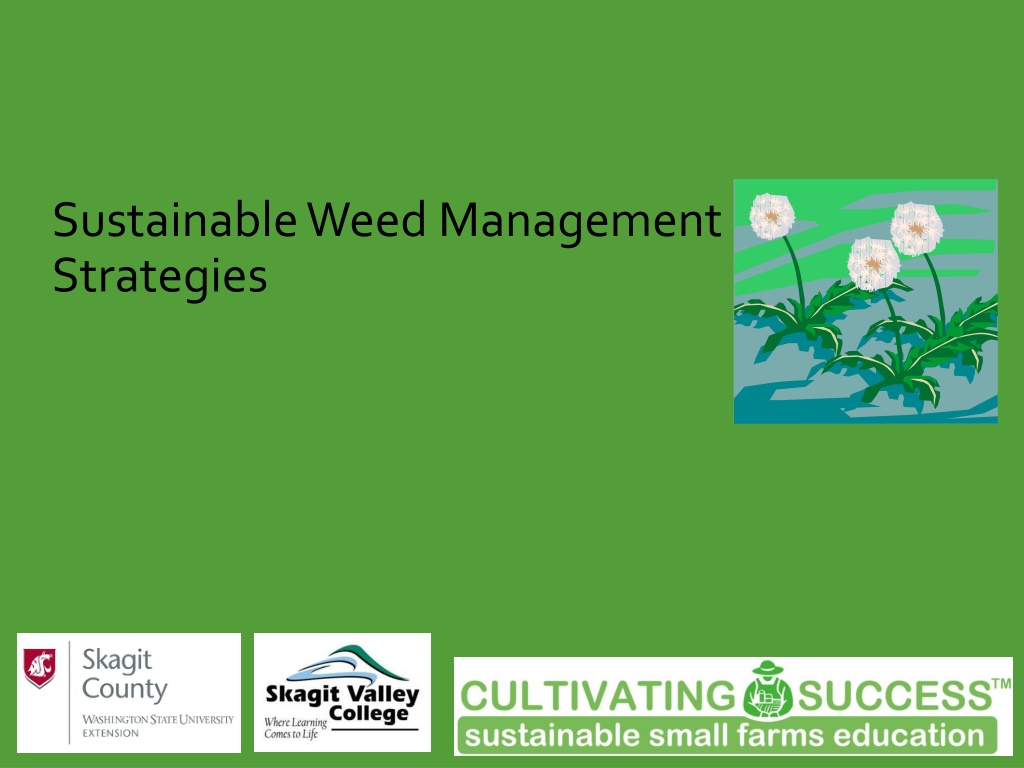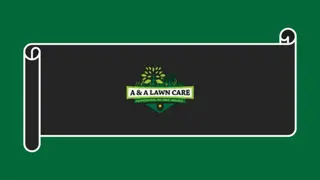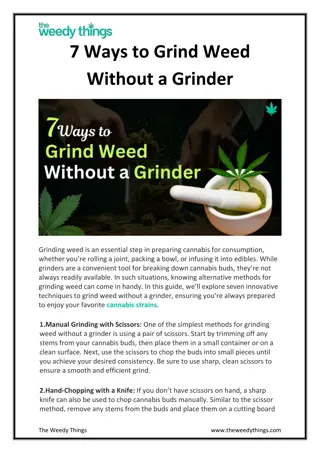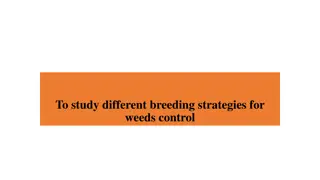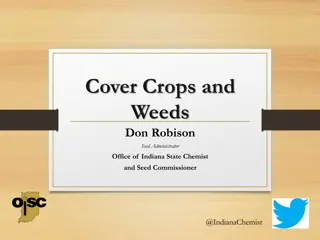Effective Strategies for Sustainable Weed Management
Discover sustainable weed management strategies involving identification, proper tools for control, composting techniques, organic production methods, and practical tips such as preventing weeds from seeding, cost-effective cultivation practices, and the benefits of cover cropping. Understanding the role of weeds and implementing proactive measures can lead to successful weed management while promoting ecosystem health in agricultural settings.
Download Presentation

Please find below an Image/Link to download the presentation.
The content on the website is provided AS IS for your information and personal use only. It may not be sold, licensed, or shared on other websites without obtaining consent from the author. Download presentation by click this link. If you encounter any issues during the download, it is possible that the publisher has removed the file from their server.
E N D
Presentation Transcript
Sustainable Weed Management Strategies
Know your Weeds ID your weeds in your field Be sure you want to get rid of it They do have a role: Holding water Creating organic matter Providing cover Habitat for beneficial insects Weeds are plant we have not yet found a use for. Weeds are any plant growing in a space intended for another.
Tools for Control Don t bring weed seeds onto the farm Nutrients brought onto the farm Raw manure will have seeds Instead of manure --Use compost! Turn the pile often to get the temp even throughout and kill seeds Be careful of source material Mulches Don t use hay Straw is better
What can I compost? Animal manures Straw, hay Vegetable matter Yard debris Wood shaving/chips Newspaper Fruit and vegetable wastes
Organic Production Compost non-animal materials Plant residues, etc No specific composting regulations
Organic Production Compost with animal materials Regulations for using compost that contains animal materials are more specific. Required minimum temperatures Required turning times Required C:N ratio
Dont let weeds go to seed! Early cycle weed control Is it worth continued harvesting from a field to justify continued weed management? Hand weeding is expensive $200-$700/Ac
Cultivating Expensive to control in row Cultivate on both sides of row Shallow tillage Brings smallest amount weeds to the top Planting techniques will help the crop out compete the weeds
Cover crop the year before Use cover crop for weed suppression Shallow tillage Brings smallest amount weeds to the top Cover cropping with winter peas for organic dry land wheat production.
Transplants Give 4+ week jump on weeds Plant at the right planting density can give you weed free plots
Irrigation Drip irrigation is more water efficient Also by directing water to the crop it minimizes weed germination and reduces need to cultivate
Timing of Cultivation Cultivate as soon as you can Small weeds easier than big weeds to remove Do not irrigate right after cultivation Depth of cultivation Depends on weed species
Equipment A large part of controlling weeds is recruitment of the appropriate technology The following is a short survey of the available equipment.
Hand Tools Photos provided by D. Muehleisen
Hand Tools Photos provided by D. Muehleisen
https://tse1.mm.bing.net/th?id=OIP.M61594d949ff384d47735227bc58aba90o0w=300h=225c=0pid=1.9rs=0p=0r=0https://tse1.mm.bing.net/th?id=OIP.M61594d949ff384d47735227bc58aba90o0w=300h=225c=0pid=1.9rs=0p=0r=0 Flamer Image result for flame weeder Image result for flame weeder tractor Image result for flame weeder tractor
Lely Tine Weeder Specially suitable for weeds with underground rhizomes Bring rhizomes to surface and causes them to desiccate Timing is critical
Bush hog Rotary mower Cutting cover crop Mowing weeds before setting seeds Photos provided by D. Muehleisen
Summary Know your weed problems Don t introduce new weeds Eliminate spread of existing weeds Compete with them cover crops, the main crop (spacing, timing, etc.) Use a variety of tools depending on situation (cultivators, flamers, hand tools)
Reading and Assignment Reading for Next Week New Organic Grower - Chapter 24 Assignments Complete Pest Management and Weed Management in Whole Farm Plan Compile the elements of sections I, II, IV and V from the Whole Farm Plan Template. Bring in a hard copy for review next week
